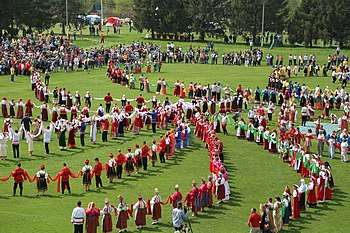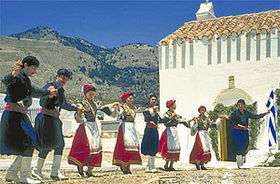Horovod
The Horovod or Khorovod (Russian: хорово́д, IPA: [xərɐˈvot], Ukrainian: хоровод, Belarusian: карагод [karaˈɣot], Bulgarian: хоро, Polish: korowód) is an East Slavic and pagan art form and one of the oldest dances of Russia with its more than 1000 years history.[1] It is a combination of a circle dance and chorus singing, similar to the choreia of ancient Greece. The dance was also known in Russia as karagod, tanok and krug.

| Look up khorovod in Wiktionary, the free dictionary. |
Etymology
The term Horovod probably descended from the Greek Choreia (Ancient Greek: χορεία). Greek culture had a strong impact on Russian culture. It cognates with Choreia (Greek circle dance), Kolo dance (South Slavic circle dance in Serbia, Croatia and Bosnia), Hora dance (Balkans), Kochari ( Armenian and Azerbaijani folk dance)
Origin and characteristics
Most significant features of the Horovod dance is to hold hands, or the little finger of the partners and dance together in a circle.
The circle dance symbolised in ancient Russian culture to "moving around the sun" and was a pagan rite with the meaning of unity and friendship. The female organizer of the dance was called khorovodnitsa, who often was the happiest, liveliest woman in the and start little bit older than the most dancers.
After the Christianization of the Rusĭy or Rus' it was common that the Horovod dance started when several marriageable girls started to sing and dance in the middle of the street, soon other girls and young men joined them. The young men brought often their instruments with them. The dance turned from a pagan custom into entertainment for young people and was used as a possibility to find a partner.
The dance could also be started in a different way, several girls in sarafans would sit next to each other and quietly sing humorous songs, the young men join the girls with soft musical accompaniment . After some time, everyone is standing up and forming a circle and start dancing.
Regional difference in Russia
The Horovod dance had own characteristic in the different regions of Old Russia.
In the Northern Russian regions, the round dance was known for its gentle, restrained, subtle manner, exceptional melody and its peculiar character, as a hint of the gentle, mysterios and strict beauty of the North, despite its calm and decent character, the Northern dances were expressive and emotionally charged. The Northern khorovod stressed the delicate and sensitive side of the Russian soul.
In the Central Russian regions, around Moscow, the dance was more cheerful and light-hearted. Russian folk songs accompanied the dance. The people kicked, clapped and made quick and energetic movements.

Dances in the Southern Russia, with its warm, mild weather, were famous for their rapid, hot-blooded movements and complex patterns, embodying strength, boundless energy and youth.[2][3]
References
- RBTH, Daria Krylova (2017-01-05). "8 facts about the khorovod, Russia's oldest dance". www.rbth.com. Retrieved 2019-05-21.
- "Russian dance Khorovod | RusClothing.com". www.rusclothing.com. Retrieved 2019-05-21.
- RBTH, Daria Krylova (2017-01-05). "8 facts about the khorovod, Russia's oldest dance". www.rbth.com. Retrieved 2019-05-21.
